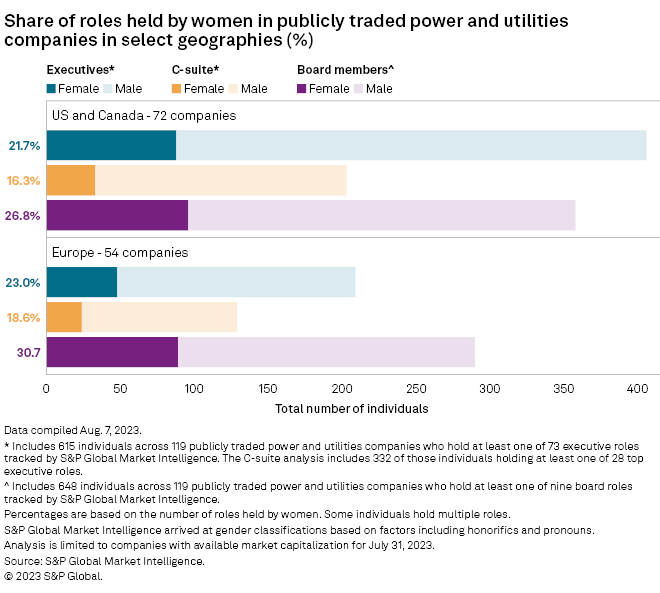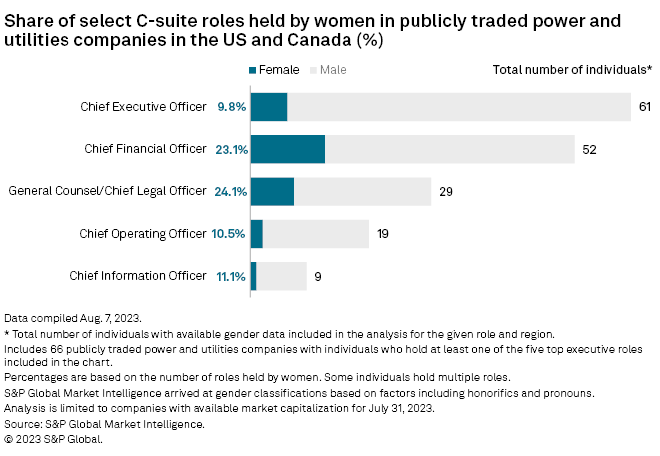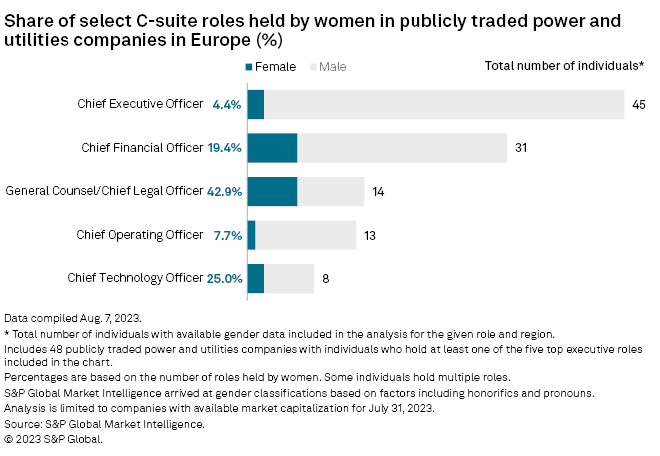Women are playing a more pivotal role in the power and utilities sector than ever, a shift that comes at what some call an opportune time as the industry evolves to meet the challenges of increasing electrification and climate change.
"We are going through a massive, massive change and having different voices in the room to solve those problems is imperative," Exelon Corp. Executive Vice President and CFO Jeanne Jones said in an interview. "If we don't have the best, the brightest, the most diverse perspectives solving those problems, we're not going to get there in the most efficient way."
While women are taking on more leadership roles in the long male-dominated power and utilities sector, the industry still has a long way to go to reach parity, according to an S&P Global Commodity Insights analysis of publicly traded companies in the US, Canada and Europe.
For the US and Canadian power and utilities companies analyzed, women hold about 16.3% of the C-suite positions, based on a review of honorifics and pronouns. More broadly, women make up 21.7% of all executive positions for these companies, and 26.8% of all board positions.

In Europe, women hold about 18.6% of C-suite roles in the companies analyzed, 23% of executive roles and 30.7% of board member positions.
Senior leaders say that this progress has been aided by the industry investing more resources in mentoring and in attracting and retaining a diverse workforce.
"We are seeing movement, but not enough," Jones said.
'The power of representation'
Jones noted that with each woman who earns a leadership role, more women see open doors.
"We're seeing the power of representation," Jones said. "Other women can look up to her and say, 'Well, I can do that, too.'"
"Sometimes we don't think about where we might go until we actually see someone who is like us in that space," said Kimberly Fontan, Entergy Corp. executive vice president and CFO.
Maria Pope, president, CEO and board member at Portland General Electric Co., said she found it helpful that she was not the first woman to lead the utility. Pope also serves on the board of the Edison Electric Institute.
"There's no question that higher water lifts all boats," Pope added. "I have a daughter who's 17 and it's really important that she's able to look at a wide variety of women in a wide variety of fields and see herself in those possibilities."
So far, women account for a small percentage of the industry's CEOs. For the US and Canadian companies analyzed, about 9.8% of CEOs are women, according to S&P Global Market Intelligence data. Among C-suite roles, women are most likely to hold the position of general counsel or chief legal officer, at 24.1%, followed by CFO, at 23.1%.
Green Mountain Power Corp. President, CEO and board member Mari McClure said the dearth of women in the top job can create a different dynamic for those who do hold the role, compared with their male counterparts.
"Say I walk into an industry meeting or somewhere else and maybe I don't know the people around the table," McClure said. "I often have to be very explicit about who I am and what I do for the organization in a way that I don't think a male CEO necessarily has to do."

The energy sector overall has tended to employ relatively few women. Despite making up about 39% of the global labor force, women account for just 16% of the energy sector workforce, according to the International Energy Agency. Wages for female employees in the energy sector are nearly 20% lower than for male employees, according to the IEA.
"Women haven't historically seen themselves in roles," McClure said. "They think to be successful you have to be a pioneer. That feels overwhelming when in reality, they are ready and they can tackle it."
In Europe, the percentage of women CEOs in the industry is even smaller, at 4.4%, according to Market Intelligence data. Among the top jobs for the European companies analyzed, the largest representation of women is found in legal departments, where they hold 42.9% of general counsel roles.

This tendency for women to end up clustered in only certain types of roles strikes Nora Steiner-Forsberg, executive vice president and general counsel for Finnish utility Fortum Oyj, as a key problem to address now.
Focusing on gender diversity alone does not go far enough, Steiner-Forsberg said, noting that her first thought upon receiving an interview request from Commodity Insights on gender diversity was, "This is a bit passé."
"One thing we still need to work on is to have women in business roles," Steiner-Forsberg said. The women who do reach the top tier of management often hold enabling functions, such as human resources or legal, "but the business roles and responsibilities are men," Steiner-Forsberg said.
Driving change
As the industry undergoes what several executives characterized as its most significant metamorphosis since the Industrial Revolution, diversity has never been more critical, they say.
"In the overall history of energy, I cannot really think of a more transformative time to be in the industry. We're at the precipice of transformational change," said Alliant Energy Corp. President and COO Lisa Barton, who is also CEO of Alliant subsidiaries Interstate Power & Light Co. and Wisconsin Power and Light Co. "Any time an industry is facing significant change and the need for agility, the more diversity you have on your team, the better off you are."
McClure likewise tied the industry's successful evolution to a diverse workforce.
"We've got a major transformation underway in how we operate the grid, and the data will show time and time again that having different perspectives — male, female, nonbinary or otherwise — equals a greater level of success," McClure said.
But even with progress, there's still a tendency to keep doing the same things, giving opportunities to the same types of people again and again.
"It's a missed opportunity to get to that next level of growth, of innovation, when you tend toward only one type of person, one way of thinking," Barton said. "There's a greater risk in not changing, in maintaining the status quo."
Companies, especially when hiring young people, should have an open mind when selecting candidates, Steiner-Forsberg said. "Do you really need to be an educated engineer for this role?" With such fields still dominated by male students, not opening the search criteria will exclude plenty of qualified women, she said.
"Recognizing the diversity of interests, the complexity of the issues, and the pace at which we need to move, female leaders are driving that change," Pope said.
Women in leadership have already proven themselves in the industry, said Jessica Weis, program director for the Women in Energy initiative at Columbia University's Center on Global Energy Policy.
"We've just seen historically that when women are given the leadership spotlight in difficult situations, like the one we're facing as a planet right now, they thrive," Weis said.
More perspectives also translate to a better bottom line, Pope said. "We have better outcomes when we have more diverse voices at the table. We drive better results."
'They want to change the world'
Even as customer expectations evolve, the expectations of people joining the industry are changing, too.
"New talent really want to make a difference," Barton said. "They want to change the world and there is no better industry where you can have an impact like the energy sector ... The pace is speeding up. There's just so many opportunities."
Walburga Hemetsberger, CEO of solar industry group SolarPower Europe, said that particular sector already has a substantial share of women executives. "It's a sector that gives you a purposeful job, working for the future of your kids," she said.
And with the need to meet vast solar capacity targets, companies must create a visibly inclusive culture if they want to succeed, Hemetsberger said. "It's a matter of survival to be attractive for people to join us."
Part of being a leader also means shedding outdated impressions of long hours and of prioritizing career over family, and instead demonstrating balance, Hemetsberger said. "It scares a lot of women away. They think they need to make a choice between family and work."
"You have to be able to see people that look like you at the top to be reassured that you have the aptitude to grow in that company," Columbia University's Weis said. "And with inclusive culture, it's remote work, it's flexibility, it's family leave policies — there's so much you can do."
A September 2023 study by the Hawthorn Club, a network of women executives in the energy industry, found systemic barriers for women's career progression "in the form of inadequate performance metrics and targets that do not reflect women's unique strengths."
Among these barriers was a male-dominated work culture that encourages a "demand and control" leadership style over one of inclusion, as well as long work hours that are difficult to combine with family life.
The Hawthorn Club laid out several remedies, including fair and transparent structures for evaluating performance and allyship from both male and female leaders that encourages the promotion of women. The group also emphasized the importance of female role models.
Steiner-Forsberg noted that Finland has a social expectation of gender equality. This allowed her to develop her career without gender playing too much of a role, she said, adding that her husband took on a large share of childcare responsibility.
The executives interviewed also stressed that women and others from underrepresented groups are their own best allies in increasing diversity across the power and utilities sector, and in guiding the industry in its clean energy transition.
"Don't take anything off the table. Don't let that little voice in your head — or anyone — tell you you don't belong, because you do and we need you," Jones said. "We need you to help solve these problems as we tackle climate change and the energy transformation. We need you."
Younger women are set to improve the current leadership statistics, Steiner-Forsberg said, adding, "I see a lot of really talented women in the pipeline. I would dare to say it will be different in five, 10 years' time."
S&P Global Commodity Insights produces content for distribution on S&P Capital IQ Pro.
Anna Duquiatan contributed to this article.
This article was published by S&P Global Market Intelligence and not by S&P Global Ratings, which is a separately managed division of S&P Global.



